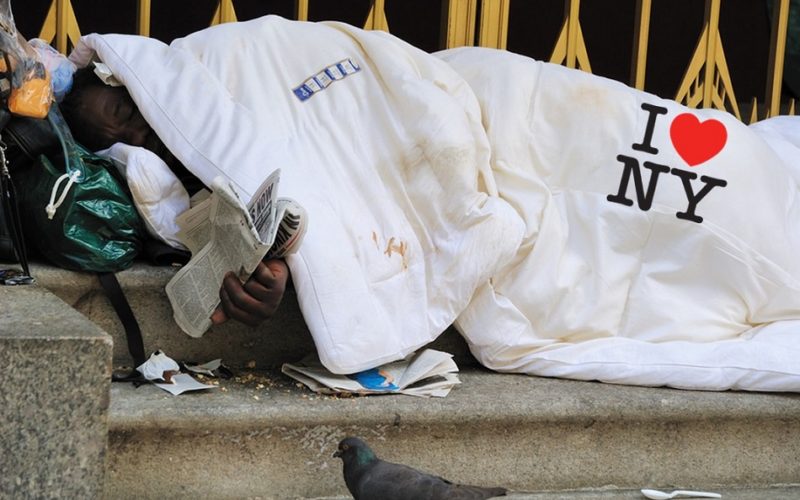Courtesy Coalition for the Homeless
The Coalition for the Homeless released its State of the Homeless 2019 report, providing a comprehensive look at homelessness in New York City. The report finds that policy failures by the City and State have exacerbated the decades-long homelessness crisis stemming from New York’s severe lack of affordable housing. In January 2019, an all-time record 63,839 men, women, and children slept in New York City shelters each night.
In 2017, Mayor de Blasio’s Turning the Tide on Homelessness plan projected a decrease in the shelter census of just 2,500 people by 2022. In contrast, State of the Homeless 2019 shows that the shelter census is on track to increase by 5,000 people by 2022 unless the Mayor immediately changes course and increases the number of apartments set aside for homeless New Yorkers through his Housing New York 2.0 plan. To achieve a meaningful decrease in the shelter census, the Mayor must implement the House Our Future NY Campaign’s recommendation to build 24,000 new apartments – and preserve at least 6,000 more – for homeless families and individuals.
As in past years, State of the Homeless includes a “report card” that grades the City and State on their respective efforts to prevent homelessness, improve shelters, and create permanent, long-term solutions to the crisis. The report evaluates these and other key policy areas that impact homeless New Yorkers.
The report card gives Mayor de Blasio a failing grade on his efforts to create sufficient housing for homeless New Yorkers and Governor Cuomo multiple failing grades on housing vouchers, homelessness prevention, and systematic cost-shifting practices that unduly burden the City. To assist the Mayor and Governor in raising their grades, the State of the Homeless 2019 outlines tools the City and State have at their disposal to reduce the number of homeless families and individuals, while also improving conditions in shelters.
“New York City’s homelessness crisis will not improve until the Mayor uses every tool at his disposal. That means devoting at least 30,000 apartments in his Housing New York 2.0 affordable housing plan for homeless New Yorkers, with at least 24,000 of those apartments to be created through new construction. With this simple change, the City can provide thousands of homeless men, women, and children with safe, clean, and stable homes,” said Giselle Routhier, policy director for the Coalition for the Homeless.
The State of the Homeless 2019 “report card” grades the City and State on their efforts to end the homelessness epidemic as follows:

Key State of the Homeless Findings:
- The last appreciable reduction in homelessness in New York City took place immediately prior to the Great Recession, and since then the shelter census has doubled.
- In February 2019, an average of 63,615 men, women, and children slept in New York City shelters each night, just shy of the all-time record set in January.
- However, the census trends by household composition diverged significantly in the past year: The number of families decreased slightly, while the number of homeless single adults increased by 9 percent.
- An all-time record 18,212 single adults slept in shelters each night in February 2019, up 150 percent from 2009. Between September 2018 and April 2019, the number of single adults in DHS shelters reached a new nightly record high 32 times.
- In fiscal year 2018, an all-time record 133,284 unique individuals spent at least one night in a New York City DHS shelter – an increase of 61 percent since fiscal year 2002 when the figure was 82,808 – fueled in large part by the increase in the number of homeless single adults.
Recommendations
State of the Homeless 2019 outlines key steps the City and State can take immediately to increase housing options for homeless New Yorkers and improve shelter conditions and processes, which will in turn dramatically reduce homelessness.
Mayor de Blasio must:
- Follow the House Our Future NY Campaign recommendation to build at least 24,000 new units of deeply subsidized, affordable housing for homeless households through the Housing New York 2.0 plan, and set aside at least 6,000 more units for homeless households through the preservation of already-occupied housing, for a total of 30,000 apartments. This goal will require that the Mayor build roughly 2,700 new apartments for homeless New Yorkers each year between 2019 and 2026, which constitutes 20 percent of the newly constructed apartments in the Housing New York 2.0
- Continue to provide at least 8,000 City-initiated rent subsidies per year to households in shelters and those at risk of eviction and homelessness.
- Establish a protocol to guarantee that all housing placements made with the use of City rent subsidies are free from conditions that could harm the health and safety of formerly homeless people or force them to return to the shelter system, and ensure that recipients are never coerced to accept inappropriate placements.
- Increase the number of Section 8 vouchers provided to homeless families from 500 per year to 2,000.
- Increase the number of public housing placements for homeless families from 2,000 per year to 3,000.
- Accelerate the timeline for the creation of 15,000 City-funded supportive housing units by scheduling their completion by 2025 rather than 2030.


















Leave a Reply